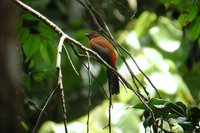|
| Query: bird | Result: 9610th of 32675 | |
Scarlet-rumped Trogon - Harpactes duvaucelii

| Resolution: 676x449
File Size: 73537 Bytes
Date: 2004:04:02 23:27:33
Camera: E990 (NIKON)
F number: f/2.9
Exposure: 10/351 sec
Focal Length: 128/10
Upload Date: 2008:07:16 11:43:54
|
|
|

